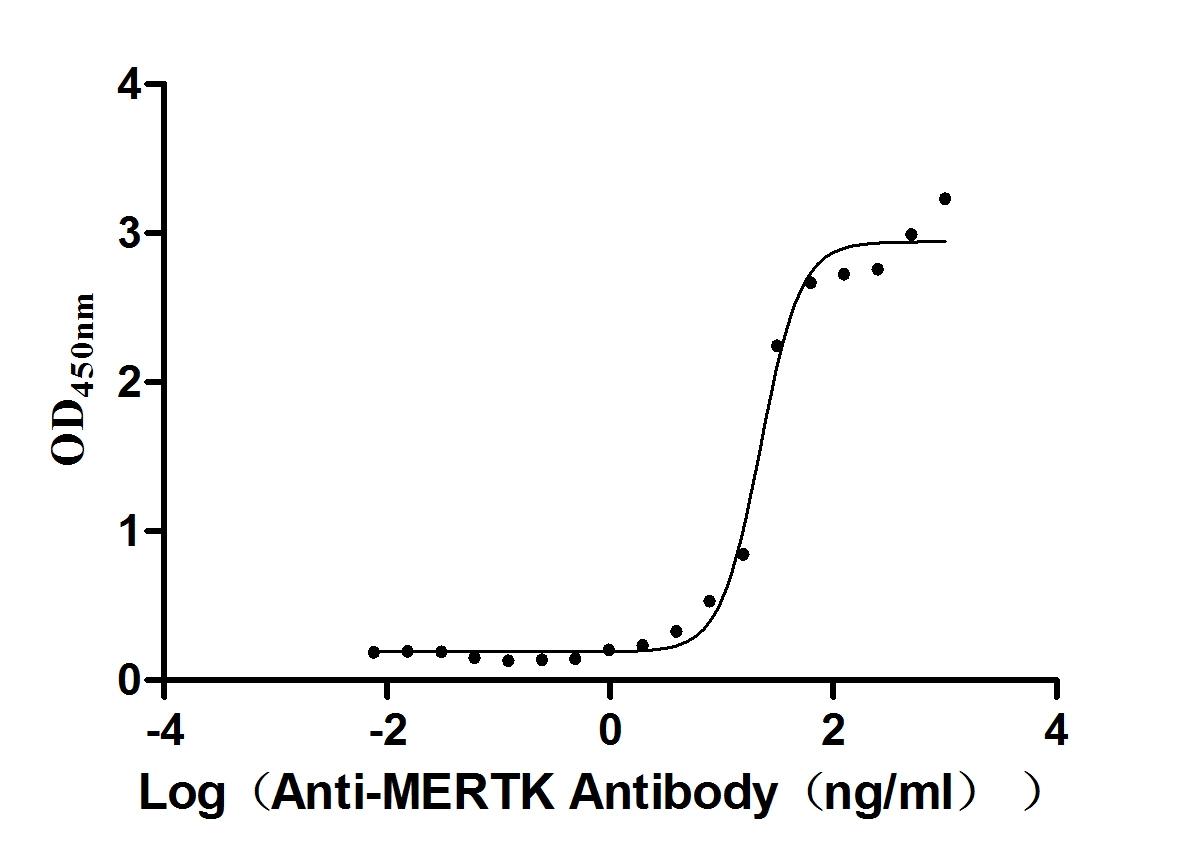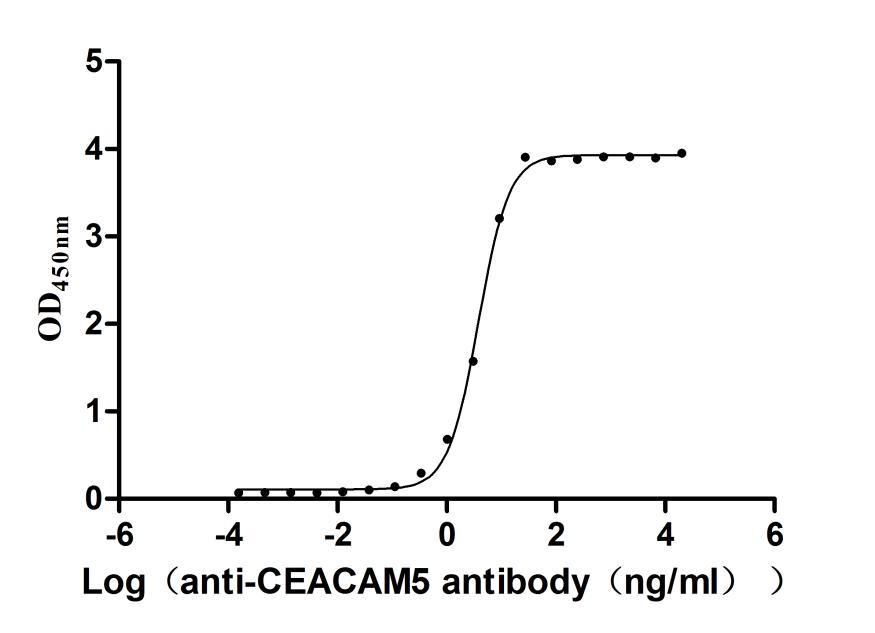Recombinant Rat Excitatory amino acid transporter 1 (Slc1a3), partial
-
中文名称:大鼠Slc1a3重组蛋白
-
货号:CSB-YP021434RA
-
规格:
-
来源:Yeast
-
其他:
-
中文名称:大鼠Slc1a3重组蛋白
-
货号:CSB-EP021434RA
-
规格:
-
来源:E.coli
-
其他:
-
中文名称:大鼠Slc1a3重组蛋白
-
货号:CSB-EP021434RA-B
-
规格:
-
来源:E.coli
-
共轭:Avi-tag Biotinylated
E. coli biotin ligase (BirA) is highly specific in covalently attaching biotin to the 15 amino acid AviTag peptide. This recombinant protein was biotinylated in vivo by AviTag-BirA technology, which method is BriA catalyzes amide linkage between the biotin and the specific lysine of the AviTag.
-
其他:
-
中文名称:大鼠Slc1a3重组蛋白
-
货号:CSB-BP021434RA
-
规格:
-
来源:Baculovirus
-
其他:
-
中文名称:大鼠Slc1a3重组蛋白
-
货号:CSB-MP021434RA
-
规格:
-
来源:Mammalian cell
-
其他:
产品详情
-
纯度:>85% (SDS-PAGE)
-
基因名:
-
Uniprot No.:
-
别名:Slc1a3; Eaat1Excitatory amino acid transporter 1; Glial glutamate transporter; Sodium-dependent glutamate/aspartate transporter 1; GLAST; GLAST-1; Solute carrier family 1 member 3
-
种属:Rattus norvegicus (Rat)
-
蛋白长度:Partial
-
蛋白标签:Tag type will be determined during the manufacturing process.
The tag type will be determined during production process. If you have specified tag type, please tell us and we will develop the specified tag preferentially. -
产品提供形式:Lyophilized powder
Note: We will preferentially ship the format that we have in stock, however, if you have any special requirement for the format, please remark your requirement when placing the order, we will prepare according to your demand. -
复溶:We recommend that this vial be briefly centrifuged prior to opening to bring the contents to the bottom. Please reconstitute protein in deionized sterile water to a concentration of 0.1-1.0 mg/mL.We recommend to add 5-50% of glycerol (final concentration) and aliquot for long-term storage at -20℃/-80℃. Our default final concentration of glycerol is 50%. Customers could use it as reference.
-
储存条件:Store at -20°C/-80°C upon receipt, aliquoting is necessary for mutiple use. Avoid repeated freeze-thaw cycles.
-
保质期:The shelf life is related to many factors, storage state, buffer ingredients, storage temperature and the stability of the protein itself.
Generally, the shelf life of liquid form is 6 months at -20°C/-80°C. The shelf life of lyophilized form is 12 months at -20°C/-80°C. -
货期:Delivery time may differ from different purchasing way or location, please kindly consult your local distributors for specific delivery time.Note: All of our proteins are default shipped with normal blue ice packs, if you request to ship with dry ice, please communicate with us in advance and extra fees will be charged.
-
注意事项:Repeated freezing and thawing is not recommended. Store working aliquots at 4°C for up to one week.
-
Datasheet :Please contact us to get it.
靶点详情
-
功能:Sodium-dependent, high-affinity amino acid transporter that mediates the uptake of L-glutamate and also L-aspartate and D-aspartate. Functions as a symporter that transports one amino acid molecule together with two or three Na(+) ions and one proton, in parallel with the counter-transport of one K(+) ion. Plays a redundant role in the rapid removal of released glutamate from the synaptic cleft, which is essential for terminating the postsynaptic action of glutamate.
-
基因功能参考文献:
- This study showed an increased expression of glial (GLAST and GLT-1) after paraoxon exposure. PMID: 27769869
- EAAT1 is regulated by CaMKII signaling and is a critical driver of constitutive glutamate uptake by EAAT1. PMID: 27889915
- Chronic postnatal stress led to increased Glast expression in hippocampus and frontal cortex. PMID: 26037264
- EAAT1 most likely mediates Na(+)-dependent high-affinity L-Glutamate (L-GLU) transport at the inner blood retinal barrier (BRB) and appears to take part in L-Glu elimination from the retina across the inner BRB PMID: 26133720
- findings suggest that NF-kappaB is a critical positive regulator of EAAT1, mediating the stimulatory effects of EGF, whereas YY1 is a negative regulator of EAAT1 with HDACs as co-repressors PMID: 26269591
- proximity between transmembrane domain 2 and hairpin loop 1 of the glutamate transporter EAAT1 PMID: 24692063
- During the latent period in this model of temporal lobe epilepsy, EAAT1 mRNA expression is down regulated in the cerebral cortex. PMID: 23392471
- Results suggest that an impairment of astrocytic ascorbate-release may exacerbate neuronal dysfunction in neurodegenerative disorders and acute brain injury in which excitotoxicity and/or GLAST deregulation have been implicated. PMID: 22886112
- We found a continuous raised hippocampal glutamate and an up-regulation of GLAST in hippocampus of aged rats associated with isoflurane-induced learning/memory impairment PMID: 23070469
- Close functional similarities of the GLAST/EAAT-1 promoter regions in man and rat exist which further point to a species-specific function of the GLAST/EAAT-1 3'-UTR in constitutive and regulated GLAST/EAAT-1 expression. PMID: 22252783
- Significantly increased expression of glutamine synthetase and glutamate aspartate transporter at 40 mmHg pressure was observed in Muller cells. PMID: 22134673
- deficient glial glutamate transporters and glutamine synthetase significantly attenuate GABAergic synaptic strength in the spinal dorsal horn PMID: 22339645
- These results indicate that GLT-1a participated in the brain ischemic tolerance induced by cerebral ischemic preconditioning in rats. PMID: 21971915
- Glast1a was present in the cerebellar Bergmann glia, and weaker labelling was evident in the retinal Muller cells. GLAST1a is differentially targeted to some cellular compartments such as the end feet of the Muller cells. PMID: 17179860
- Glutamate transporter GLAST is downregulated in hippocampus and cerebral cortex following subarachnoid hemorrhage. PMID: 21233495
- Results indicate a transient decrease in GLAST glutamate transporter RNA expression during the early stages of a spatial learning task. PMID: 20521381
- GLAST can rapidly and specifically respond to changes in the cellular environment thus potentially helping to fine-tune the functions of astrocytes. PMID: 19440835
- GLAST-1 may regulate glutamate signalling in bone, consistent with its operation in the central nervous system PMID: 12440940
- EAAT1 has a role in myocardial glutamate metabolism PMID: 15242733
- Glia modulate the expression of GLAST glutamate transporters in neurons, via at least two distinct mechanisms PMID: 15337311
- EAAT1 regulation by thyroid hormone may facilitate increased metabolic demands of the cardiomyocyte during hyperthyroidism and impact cardiac function in hyperthyroidism. PMID: 15615843
- we report the identification of five splice variants of the 5'-leader sequence of rat GLT-1 which contain varying numbers of upstream open reading frames and encode putative GLT-1 proteins, and are expressed in a brain region-specific manner. PMID: 15661376
- While most glia in the NG2 lineage preserve a certain amount of voltage-gated ion conductances, mature GLAST(+) astrocytes are electrophysiologically passive. PMID: 16093329
- GLAST downregulation, mediated by tumor necrosis factor-alpha, has a role in autoantigen-specific T cells inhibition of glutamate uptake in astrocytes PMID: 16123171
- Correlation of post-whole cell recording immunohistochemistry for GLAST and the spread of injected dye from the recorded cell with the measured electrophysiological phenotype to quantify cell coupling of astrocytes. PMID: 16775204
- GLAST in supporting cells is responsible for transmitter uptake at IHC afferent synapses. (Glutamate-aspartate transporter GLAST) PMID: 16855093
- GLAST was expressed primarily in epithelial cells, cells of the macrophage-lineage, lymphocytes, fat cells, interstitial cells, and salivary gland acini PMID: 16868771
- These age-related alterations in Glast and glutamate regulation may be key contributors to the increased susceptibility of the aged brain to excitotoxic insults such as stroke and hypoxia. PMID: 16959378
- These findings implicate the GLAST-NHERF1 complex in the regulation of glutamate homeostasis in astrocytes. PMID: 17048262
- Overall, in tissue sections [(3)H]4MG proved unsuitable for studying the autoradiographic localization of EAATs apparently due to its inability to selectively discriminate Na(+)-dependent binding to Glu transporters. PMID: 17590480
- GLAST cytoskeletal anchoring determines susceptibility to brain damage and identifies the role for GFAP PMID: 17684014
- Glutamate transport does not appear to change linearly with increased IOP; A pressure threshold exists, above which Muller cell GLAST function is compromised PMID: 18028233
- Data show that GLAST expression is decreased in the hippocampal CA1 region in rats with global cerebral ischemia with or without epilepsy. PMID: 18671901
- In the hippocampus of group II metabotropic glutamate receptor GluR3-deficient mice, glutamate transporters EAAT1 and EAAT2 are decreased. PMID: 18720515
- The alpha1-alpha 3 subunits of Na,K-ATPase were detected, as were the glutamate transporters GLAST and GLT-1, demonstrating that glutamate transporters copurify with Na,K-ATPases. PMID: 19553454
- InHO and tMCAO are associated with expression of EAAT1, EAAT2, EAAT3, and TACE, consistent with an active role in the genesis of ischemic protection. PMID: 19717015
显示更多
收起更多
-
亚细胞定位:Cell membrane; Multi-pass membrane protein.
-
蛋白家族:Dicarboxylate/amino acid:cation symporter (DAACS) (TC 2.A.23) family, SLC1A3 subfamily
-
组织特异性:Detected in brain and cerebellum. Both isoform GLAST-1 and GLAST-1A are expressed in bone and brain. In brain isoform GLAST-1 is highly enriched in the Purkinje cell layer in cerebellum.
-
数据库链接:
KEGG: rno:29483
STRING: 10116.ENSRNOP00000022319
UniGene: Rn.34134
Most popular with customers
-
Recombinant Human B-lymphocyte antigen CD20 (MS4A1)-VLPs (Active)
Express system: Mammalian cell
Species: Homo sapiens (Human)
-
Recombinant Human C-X-C chemokine receptor type 4 (CXCR4)-VLPs (Active)
Express system: Mammalian cell
Species: Homo sapiens (Human)
-
Recombinant Human Intestinal-type alkaline phosphatase (ALPI) (Active)
Express system: Mammalian cell
Species: Homo sapiens (Human)
-
Recombinant Mouse Tyrosine-protein kinase Mer (Mertk), partial (Active)
Express system: Mammalian cell
Species: Mus musculus (Mouse)
-
Recombinant Human Carcinoembryonic antigen-related cell adhesion molecule 8(CEACAM8) (Active)
Express system: Mammalian cell
Species: Homo sapiens (Human)
-
Express system: Mammalian cell
Species: Macaca mulatta (Rhesus macaque)



-AC1.jpg)














